The Camino de Santiago Part V
We are now departing Portomarín en route to Palas de Rei. I’d like to stress that, for me, the meaning of the pilgrimage lies in the walking itself. The beauty of the quiet countryside certainly enhances the experience, yet a pilgrimage involves both an inner and an outer process, and both are valuable.
For those who believe that “signs” may appear along the way – and I am one of them – the following pictures illustrate a very personal experience that I had on the road to Palas de Rei. It was a Sunday morning when we reached a small village in the countryside. Most inns and other rest stops were closed, but one was open, and we stopped there to purchase a fresh orange juice and large bottle of water.
No sooner did we enter the restaurant than we heard the music of Johann Sebastian Bach playing on the stereo system! And one of the works being played was the Magnificat, which the New Mexico Bach Society performed two seasons ago in celebration of Bach’s 330th birthday. When I heard the clarion trumpets, tears came to my eyes. The owner of this small albergue told me how much he loves the music of Bach. And this beautiful music continued to play for the entire time that we were in the garden enjoying a cool drink. Here are two photos of the alberque and outdoor dining area:
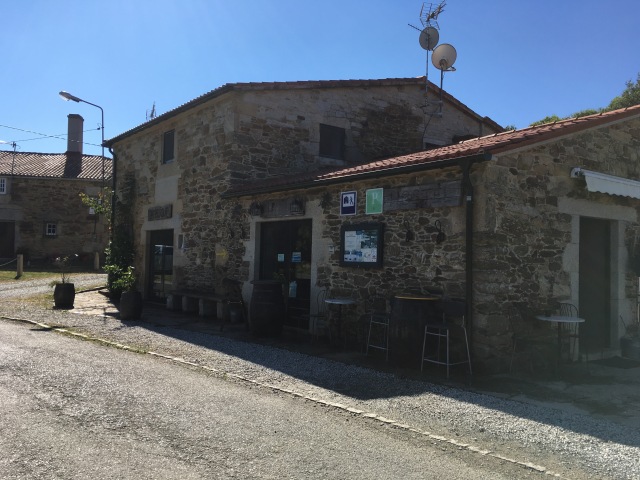
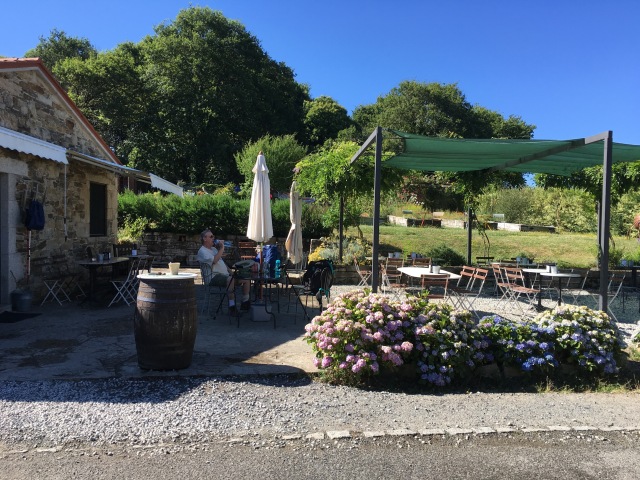
One of the reasons that my pilgrimage on the Camino was so timely is that, for the past four years, I had been working 80+ hours per week to help New Mexico Performing Arts Society come to life as a high-quality presenter of concerts, small art exhibits and presenter of other performing arts by New Mexico-based musicians and artists. If our music director, Franz Vote, and I had realized what we were taking on, we might have thought twice, because giving birth to a new organization is no small task! In spring 2016, I realized that I had run out of energy reserves and needed a real break to reflect on my life and work.
Some of you may recall the book by Gail Sheehy about the meaning of each decade of life – if memory serves, it is called Passages. It has been true for me that, when I reach the 10-year milestone, I take time out to celebrate the previous decade of life and to consider what lies ahead. So this trip on the Camino was part of that celebration, yet even more significant at this point in time for the above-mentioned reasons.
When I heard the music of Johann Sebastian Bach that morning in a tiny village in the countryside of Galicia, it felt as though the creative force of the universe was letting me know that we were on the right path at this point in time. In addition, I had performed two concerts in Germany, so my flute was in my backpack for the entire trip on the Camino. Music was literally with me throughout the journey, and this did not escape my notice.
As we were leaving that tiny village, a farmer came along in the opposite direction, driving two of his longhorn cattle in front of him. They literally came within a foot or two of us, and for a brief moment I wondered if the cattle would react aggressively. But there was no need for concern, because they were placid as can be. And the farmer greeted us warmly with “Buenos días, buen Camino.” He was wishing us well with the standard phrase that one hears all along the Camino from townspeople and other pilgrims alike.
Here are several photos of the route on Day 2 of the route from Sarría to Santiago de Compostela …
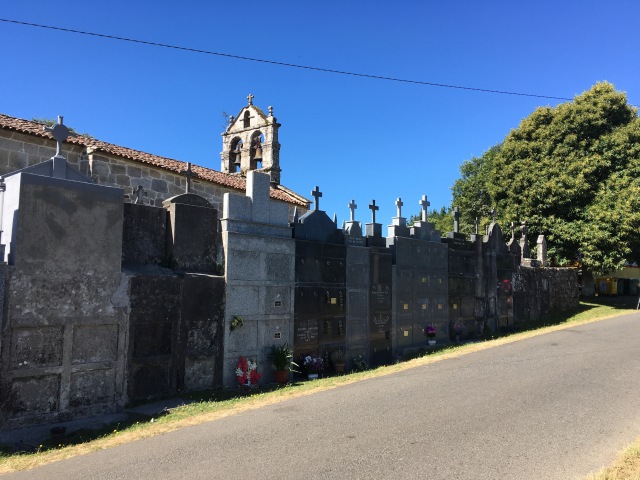
A typical village church in Galicia
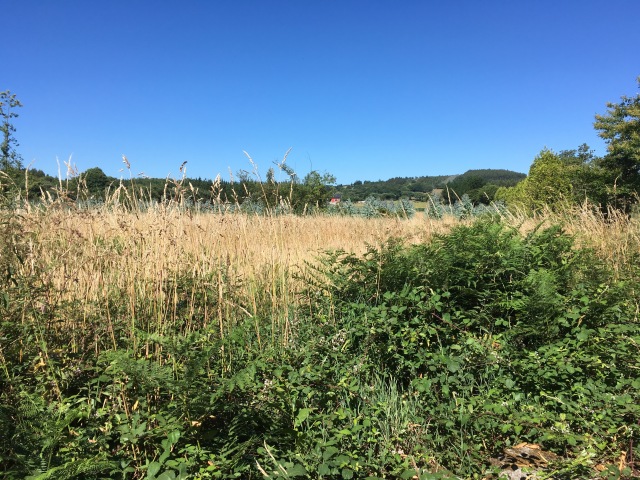
Wheat fields en route to Palas de Rei – in the background, a stand of young eucalyptus trees
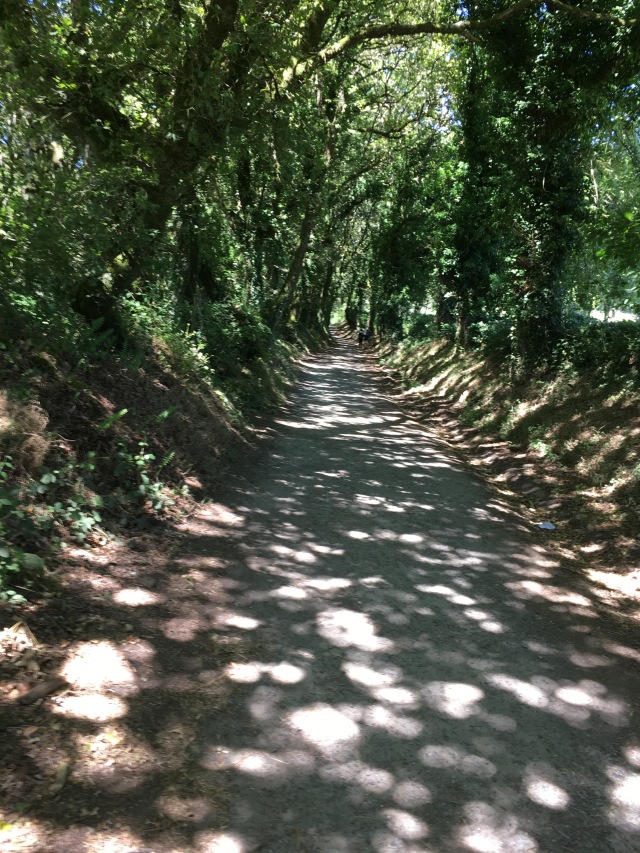
An oak forest along the Camino between Portomarín and Palas de Rei – when you are in the forest, it feels as though you are completely away from modern life in a very peaceful, quiet place. This was one of my favorite spots along the Camino.
We arrived in Palas de Rei in the late afternoon, checked into our hotel and went in search of a nice place for an early dinner. Our hotel owner suggested one local restaurant that didn’t close between mid-day and dinner, which usually begins at 8 pm in Spain. And if you arrive for dinner right at 8, you will probably have the restaurant almost entirely to yourself, because the Spanish don’t usually eat dinner in summertime until 10 pm or later.
After a good night’s sleep, we headed out on Day 3 of the Camino from Palas de Rei to Melide. On every farm property, we noticed a kind of structure with a tile roof that piqued our curiosity. Can you guess what this is?
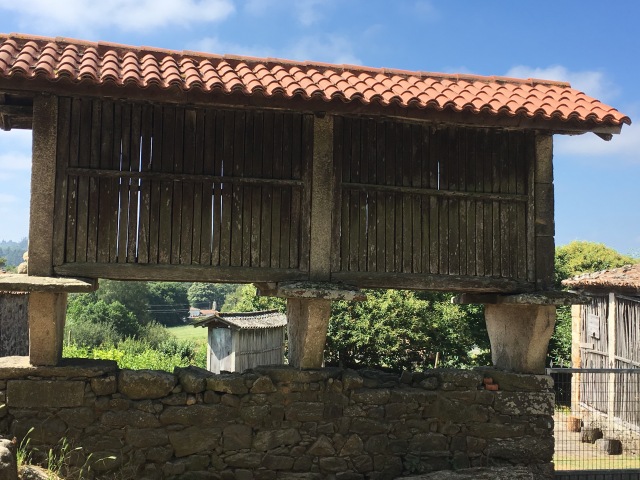
Nearly every farm we passed had an hórreo (granary) by the roadside. I noticed them on Day 1 and, by day 3, was really curious to know what purpose they served. We asked at a local restaurant, and they told us that it was used to store corn. Not only does an hórreo help the corn to dry effectively without molding, it also keeps the corn away from rats and other rodents that would eat it.
For those of us who have not grown up in agricultural areas, these kinds of discoveries bring us much closer to the land. We experience the ways in which man has ingeniously figured out how to harvest and make the best use of crops. Galicia is incredibly fertile, probably because it gets so much rain throughout the year. We noticed that most of the land we saw in Galicia, Castilla y León and the Basque Country is used to grow crops – there was lots of grain growing everywhere, but even more so in Galicia than in these other areas. And the Camino takes pilgrims right through little towns and villages where they must step over cow pies as they continue on their way. Personally, I loved this intimate view into the lives of the people of Galicia.
I must add here that, like cities everywhere in the developed world, Spain’s bigger cities show signs of urban sprawl. Yet the Spanish have managed to preserve the older parts of their cities better than we have here in the US. When we lived in Germany, I noticed that Germans were not only informed about the history of their region – they memorialized it by meticulously documenting everything about their cities, towns, ancient structures and monasteries. And the same holds true for their cultural history. People in Europe seem to have a much greater sense of the value of their traditions and the institutions that have guided them from ancient times through the present. One definitely also gets this feeling in Spain, and I absolutely loved being witness to more than 2,000 years of history at every turn.
Let me conclude Part V of the Camino de Santiago by mentioning that Melide will be featured in Part VI. This again proved to be an extremely special day for us, because we arrived in Melide on the Feast Day of St. James the Apostle, which is a national holiday in Spain. We attended mass at the main church in Melide and celebrated Santiago Apostol (July 25th) with the assembled congregation. Here is a photo of the interior of the church. More on this and Day 4 in the next installment:

Altar area of the main church in Melide where we celebrated the Feast of St. James with members of the local community.
Please watch for the next post in the series. Part V has prompted me to write another related post about founding the New Mexico Performing Arts Society, which is another kind of “pilgrimage” on life’s journey.

Leave a Reply
Want to join the discussion?Feel free to contribute!